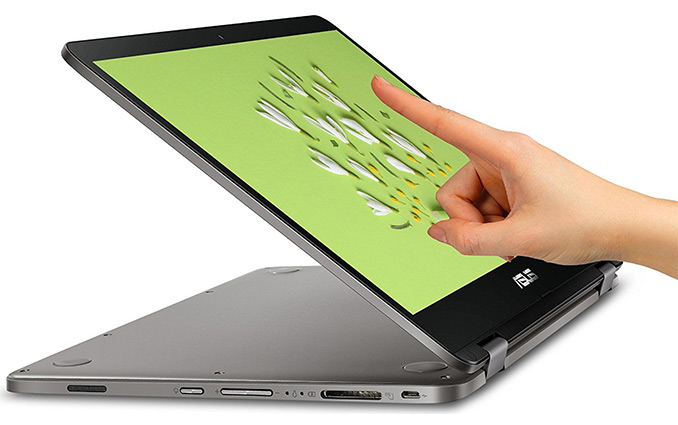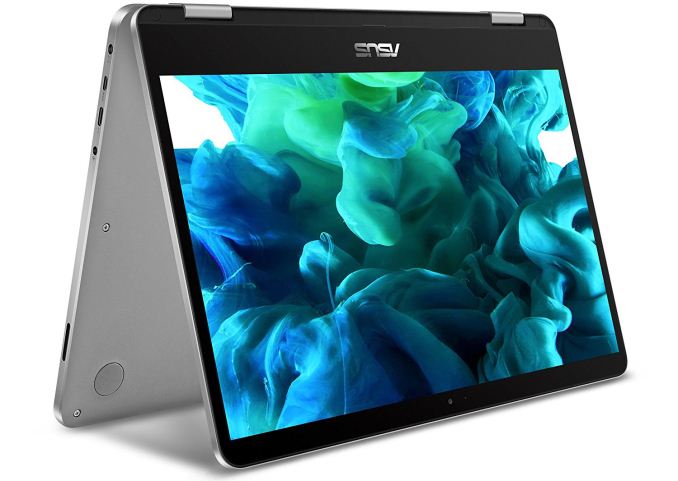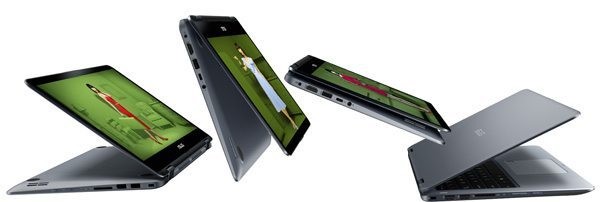ASUS VivoBook Flip 14 TP401 Convertible Launched: $549 with Core m3
by Anton Shilov on October 23, 2017 11:00 AM EST
ASUS has started to sell its new entry-level convertible laptop, based on an Intel 7th generation Core m3 processor (Kaby Lake-Y) SoC. Convertable in this case means the rotation of the hinge, allowing the notebook to 'convert' into a tablet. The combination of a relatively affordable price point ($549) with a very energy-efficient Core-based processor has a potential to make the VivoBook Flip 14 TP401 popular among customers with budget constraints seeking for a hybrid mobile PC.
Convertibles are believed to be a growing category, on the otherwise declining PC market, because many people want to use their devices both as laptops and as tablets. Historically, large computer suppliers positioned convertibles as higher-end machines worth a premium and charged accordingly. Last year Intel proposed to use its low-cost/low-power Atom platform for convertibles to make them cheaper but without compromising battery life. Since then, a number of companies have introduced appropriate products to address the entry-level segment of the market. At the same time, PC makers are trying to lower costs of convertibles based on Intel’s high-performance Core microarchitecture to address the mainstream segment and traditional customers who buy $500 - $700 PCs. Earlier this year Acer introduced its Switch 3 detachable machine based on a Kaby Lake Celeron SoCs, and that device started at $399. Now, ASUS has started to sell its VivoBook Flip 14 TP401 that features a higher-performance SoC, but serves the same purpose: introduces Intel’s high-performance microarchitecture to an inexpensive convertible laptop.
The ASUS VivoBook Flip TP401 is 14” hybrid notebook based on Intel’s Core m3-7Y30 SoC with up to 4.5 W TDP. The model in question (TP401CA-DHM6T) is equipped with 4 GB of LPDDR3 memory as well as a 128 GB eMMC storage solution. For connectivity, the convertible uses an 802.11ac Wi-Fi + BT 4.1 wireless module, has one USB 3.0 Type-C port, one Micro USB 2.0 port, a micro-HDMI display output, a 3.5mm TRRS audio jack, an SDXC card reader and so on.
Unlike many entry-level systems, the ASUS VivoBook Flip TP401 comes in an enclosure made of an aluminum alloy that gives a feel of a premium product. This premium feeling is somewhat spoiled by the screen resolution (1366×768 pixels) that seems to be low by modern standards, but it does have wide viewing angles suggesting this is a reasonable panel (i.e. not TN). The 360° multi-gear hinges are made of stainless steel and can handle 20,000 open-and-close cycles, according to the manufacturer. The hinges support notebook mode, tablet mode, 'tent' mode, and an 'entertainment' mode.
As for physical dimensions and weight, the VivoBook Flip TP401 is 15.4 mm thick and weighs around 1.5 kilograms, which is slightly thicker and heavier when compared to higher-end laptops, but is good enough considering the price of this convertible and its screen size. For some reason, ASUS does not specify for how long the unit can work on one battery charge, but only says that the TP401CA-DHM6T comes with a 39 Wh accumulator and "lasts for a day".
| ASUS VivoBook Flip 14 TP401 Convertible | ||||
| TP401CA-DHM6T | ||||
| Display | Resolution | 1366×768 | ||
| Panel | 14" 178° viewing angles |
|||
| SoC | Intel Core m3-7Y30 2C/4T 1.0 GHz base 2.6 GHz turbo 4 MB LLC 4.5W Intel HD 615 |
|||
| RAM | 4 GB LPDDR3 | |||
| Storage | 128 GB eMMC | |||
| Camera | VGA webcam | |||
| Wireless | 802.11ac Wi-Fi Bluetooth 4.1 |
|||
| I/O ports | 1 × USB 3.0 Type-C 1 × Micro-USB 2.0 1 × SDXC Card reader 1 × micro HDMI |
|||
| Audio | 2 × Speakers w/ ASUS SonicMaster 1 × TRRS 3.5-mm jack for headset |
|||
| Dimensions | Width | 327.4 mm / 12.89" | ||
| Depth | 226.5 mm / 8.92" | |||
| Height | 15.4 mm / 0.61" | |||
| Weight | ~1.5 Kg / 3.3 lbs | |||
| Battery | 39 Wh | |||
| OS | Windows 10 Home | |||
| Finish | Light Gray | |||
The ASUS VivoBook Flip 14 TP401CA-DHM6T is available immediately for $549 directly from ASUS as well as from retailers like Amazon.
Related Reading
Source: ASUS














39 Comments
View All Comments
BrokenCrayons - Monday, October 23, 2017 - link
I can sympathize with the low resolution problems, but I think given the price bracket, this thing isn't being aimed at VNC or programming chores. Then again, like I said, if I had to use a 1080p screen, I'd end up scaling at 150% so I'd personally lose some of the screen real estate to increasing the size of things so I can actually see them without eye strain.Also, this isn't 720p. It's 1366x768 and 720p is 1280x720 so you're getting a few more rows of pixels of both length and height.
damianrobertjones - Monday, October 23, 2017 - link
This machine should be in a much lower price bracket. You know it and I know it. There's no justification for this machine being at the price it is.Manch - Tuesday, October 24, 2017 - link
Try adjusting the brightness relative to the lighting conditions in the room. That will help with eye strain and focusing. Higher res screens, like 1080 would probably be ok for you, but you need to find the optimal viewing distance. If you're getting old, reading glasses.I'm near sighted a bit and I find its actually easier on my eyes to take my glasses off when using my laptop or tablets. Being near sighted, my glasses decrease the natural magnification of my eyes a bit and strain the eyes a bit when reading which I do a lot of.
HStewart - Monday, October 23, 2017 - link
Please not the system has support up 4K and 3 monitors externallyEiny0 - Monday, October 23, 2017 - link
I agree on all but price. Even $499 is too much given the hardware and expected 1 year warranty. If they priced at $399 it would sell like hotcakes. Even at $450 would sell well, it's a value machine and it needs a value price point to sell IMO.hybrid2d4x4 - Monday, October 23, 2017 - link
As an owner of an Asus T100, the main issue of the eMMC isn't so much the quantity, but just how dismally slow this storage is- like mid 90s hard drive in sustained write speeds. Copying files over the USB3 port, the flash in that thing struggled to do 30MB/s when writing to the eMMC. The read speeds were faster but still a small fraction of what a modern 2.5" spinning drive does. The random reads are the only thing that might be better than a HDD. I have a cheaper/older SSD in my main PC and the occasional time I use the T100, it feels like I'm stepping 10 years into the past with how slow the disk access is.The memory card reader (microSD) on the T100 is also gimped at ~13MB/s, so I would expect this laptop to have similar compromises.
TBH, this device looks a lot like the Cherry/Bay-trail based netbooks/tablets with just the CPU updated and nothing else, and with a bigger/worse screen and seemingly better materials/build quality. I don't think that's worth anywhere near their asking price, to me even 400 would be a tough sell...
BrokenCrayons - Tuesday, October 24, 2017 - link
I had an ASUS x205TA which was a Bay Trail system using 32GB eMMC. It was similarly slow, but I wouldn't use a Bay Trail laptop as a basis for what you might see out of a much newer system like this one. eMMC storage performance has improved by quite a bit in the intervening years so it might be better not to base your expectations of storage performance on the T100.HStewart - Monday, October 23, 2017 - link
The y7y30 can handle up to 16G of memory but not sure this notebook is expandable.Also I have seen m2 SSD slot in Pentium ( Atom based ) laptop which has extremely lower performance than the Core m series.
damianrobertjones - Monday, October 23, 2017 - link
You could buy a laptop, with better specs, for less a few years back. You've basically approved oems putting up their prices for bottom bracket parts. Well done.BrokenCrayons - Tuesday, October 24, 2017 - link
Instead of accusing me of being responsible for a price you think isn't fair, you could work to raise your income so you could afford the things you want at their retail price.